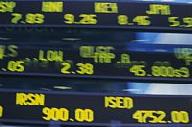
 |
|
| Financial Terms | |
| Macroeconomics |
|
Information about financial, finance, business, accounting, payroll, inventory, investment, money, inventory control, stock trading, financial advisor, tax advisor, credit.
Main Page: inventory, inventory control, financial advisor, accounting, money, finance, credit, financial, |
Definition of Macroeconomics
MacroeconomicsThe study of the determination of economic aggregates such as total output and the price level.
Related Terms:Classical MacroeconomicsThe school of macroeconomic thought prior to the rise of Keynesianism. New ClassicalsEconomists who, like classical economists, believe that wages and prices are sufficiently flexible to solve the unemployment problem without help from government policy. Price-specie-flow mechanismAdjustment mechanism under the classical gold standard whereby economic components modelAbrams’ model for calculating DLOM based on the interaction of discounts from four economic components. Absolute priorityRule in bankruptcy proceedings whereby senior creditors are required to be paid in full Arm's length priceThe price at which a willing buyer and a willing unrelated seller would freely agree to Ask priceA dealer's price to sell a security; also called the offer price.  Bargain-purchase-price optionGives the lessee the option to purchase the asset at a price below fair market Basis priceprice expressed in terms of yield to maturity or annual rate of return. Bid priceThis is the quoted bid, or the highest price an investor is willing to pay to buy a security. Practically Call priceThe price, specified at issuance, at which the issuer of a bond may retire part of the bond at a Call priceThe price for which a bond can be repaid before maturity under a call provision. Clean priceBond price excluding accrued interest. Coefficient of determinationA measure of the goodness of fit of the relationship between the dependent and Confidence levelThe degree of assurance that a specified failure rate is not exceeded. Consumer Price Index (CPI)The CPI, as it is called, measures the prices of consumer goods and services and is a  Conversion parity priceRelated:Market conversion price Convertible priceThe contractually specified price per share at which a convertible security can be Delivery priceThe price fixed by the Clearing house at which deliveries on futures are in invoiced; also the Devaluation A decrease in the spot price of the currency
Dirty priceBond price including accrued interest, i.e., the price paid by the bond buyer. Dollar price of a bondPercentage of face value at which a bond is quoted. Earnings surprisesPositive or negative differences from the consensus forecast of earnings by institutions Economic assumptionseconomic environment in which the firm expects to reside over the life of the Economic defeasanceSee: in-substance defeasance. Economic dependenceExists when the costs and/or revenues of one project depend on those of another. Economic earningsThe real flow of cash that a firm could pay out forever in the absence of any change in Economic exposureThe extent to which the value of the firm will change because of an exchange rate change. Economic incomeCash flow plus change in present value. Economic order quantity (EOQ)The order quantity that minimizes total inventory costs. Economic rentsProfits in excess of the competitive level. Economic riskIn project financing, the risk that the project's output will not be salable at a price that will Economic surplusFor any entity, the difference between the market value of all its assets and the market Economic unionAn agreement between two or more countries that allows the free movement of capital, Effective call priceThe strike price in an optional redemption provision plus the accrued interest to the Equilibrium market price of riskThe slope of the capital market line (CML). Since the CML represents the Event studyA statistical study that examines how the release of information affects prices at a particular time. Exercise priceThe price at which the underlying future or options contract may be bought or sold. Fair market priceAmount at which an asset would change hands between two parties, both having Fair priceThe equilibrium price for futures contracts. Also called the theoretical futures price, which equals Fair price provisionSee:appraisal rights. Fixed price basisAn offering of securities at a fixed price. Fixed-price tender offerA one-time offer to purchase a stated number of shares at a stated fixed price, Flat price riskTaking a position either long or short that does not involve spreading. Flat price (also clean price)The quoted newspaper price of a bond that does not include accrued interest. Full priceAlso called dirty price, the price of a bond including accrued interest. Related: flat price. Futures priceThe price at which the parties to a futures contract agree to transact on the settlement date. Government sponsored enterprisesPrivately owned, publicly chartered entities, such as the Student Loan High priceThe highest (intraday) price of a stock over the past 52 weeks, adjusted for any stock splits. Input-output tablesTables that indicate how much each industry requires of the production of each other Invoice priceThe price that the buyer of a futures contract must pay the seller when a Treasury Bond is delivered. Law of one priceAn economic rule stating that a given security must have the same price regardless of the Leading economic indicatorseconomic series that tend to rise or fall in advance of the rest of the economy. Level payThe characteristic of the scheduled principal and interest payments due under a mortgage such that Level-coupon bondBond with a stream of coupon payments that are the same throughout the life of the bond. Limit priceMaximum price fluctuation Low priceThis is the day's lowest price of a security that has changed hands between a buyer and a seller. Low price-earnings ratio effectThe tendency of portfolios of stocks with a low price-earnings ratio to Limit priceMaximum price fluctuation Market conversion priceAlso called conversion parity price, the price that an investor effectively pays for Market price of riskA measure of the extra return, or risk premium, that investors demand to bear risk. The Market pricesThe amount of money that a willing buyer pays to acquire something from a willing seller, Marketplace price efficiencyThe degree to which the prices of assets reflect the available marketplace Maximum price fluctuationThe maximum amount the contract price can change, up or down, during one Minimum price fluctuationSmallest increment of price movement possible in trading a given contract. Also Nominal priceprice quotations on futures for a period in which no actual trading took place. Opening priceThe range of prices at which the first bids and offers were made or first transactions were Option priceAlso called the option premium, the price paid by the buyer of the options contract for the right Price/book ratioCompares a stock's market value to the value of total assets less total liabilities (book Price/earnings ratio (PE ratio)Shows the "multiple" of earnings at which a stock sells. Determined by dividing current Price/sales ratio (PS Ratio)Determined by dividing current stock price by revenue per share (adjusted for stock splits). Price compressionThe limitation of the price appreciation potential for a callable bond in a declining interest Price discovery processThe process of determining the prices of the assets in the marketplace through the Price elasticitiesThe percentage change in the quantity divided by the percentage change in the price. Price impact costsRelated: market impact costs Price momentumRelated: Relative strength Price persistenceRelated: Relative strength Price riskThe risk that the value of a security (or a portfolio) will decline in the future. Or, a type of Price takersIndividuals who respond to rates and prices by acting as though they have no influence on them. Priced outThe market has already incorporated information, such as a low dividend, into the price of a stock. Price value of a basis point (PVBP)Also called the dollar value of a basis point, a measure of the change in Pricesprice of a share of common stock on the date shown. Highs and lows are based on the highest and Price-specie-flow mechanismAdjustment mechanism under the classical gold standard whereby Price-volume relationshipA relationship espoused by some technical analysts that signals continuing rises Put priceThe price at which the asset will be sold if a put option is exercised. Also called the strike or Resistance levelA price level above which it is supposedly difficult for a security or market to rise. Return on total assetsThe ratio of earnings available to common stockholders to total assets. Reverse price riskA type of mortgage-pipeline risk that occurs when a lender commits to sell loans to an Settlement priceA figure determined by the closing range which is used to calculate gains and losses in Spot priceThe current marketprice of the actual physical commodity. Also called cash price. Stated conversion priceAt the time of issuance of a convertible security, the price the issuer effectively Strike priceThe stated price per share for which underlying stock may be purchased (in the case of a call) or Subscription priceprice that the existing shareholders are allowed to pay for a share of stock in a rights offering. Support levelA price level below which it is supposedly difficult for a security or market to fall. Theoretical futures priceAlso called the fair price, the equilibrium futures price. Total asset turnoverThe ratio of net sales to total assets. Total debt to equity ratioA capitalization ratio comparing current liabilities plus long-term debt to Total dollar returnThe dollar return on a nondollar investment, which includes the sum of any Total returnIn performance measurement, the actual rate of return realized over some evaluation period. In Total revenuetotal sales and other revenue for the period shown. Known as "turnover" in the UK. Transfer priceThe price at which one unit of a firm sells goods or services to another unit of the same firm. Variable price securityA security, such as stocks or bonds, that sells at a fluctuating, market-determined price. RATE OF RETURN ON TOTAL ASSETSThe percentage return or profit that management made on each dollar of assets. The formula is: Related to : financial, finance, business, accounting, payroll, inventory, investment, money, inventory control, stock trading, financial advisor, tax advisor, credit. |